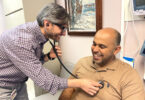Picture this scenario: you develop an infection, are given penicillin and then develop a serious rash. Your first logical suspicion may be that you have an allergy. After talking to your doctor, you may be given a different drug and told to avoid penicillin forever. It all sounds very rational. The problem is, it isn’t.
At Sunnybrook’s Drug Safety Clinic, hundreds of people are tested every year for drug sensitivities and allergies. And doctors there say, the vast majority of people who think they are allergic to penicillin actually may never have been or are not any longer. These findings are supported by many studies. Dr. Elizabeth Weber, director of drug testing at the Clinic, says there are so many other possible explanations, including drug-drug interactions, drug-food interactions, drug-viral or bacterial interactions or the infection itself. But those are often overlooked because they need more probing.
So what difference does it make if you avoid penicillin and opt for other drugs instead? Dr. Weber says people may be given antibiotics that are more toxic than penicillins, or that are not first-line choice drugs for the infection. Penicillins, which have been around for decades, are a group of related antibiotics that were among the first to work against serious bacterial infections. Even though many kinds of bacteria have developed resistance, penicillins remain major first-line players that often costs less.
If you have a suspected penicillin allergy – even since childhood – you can literally settle the question in just a few hours by undergoing testing. First, a registered nurse will document your blood pressure and other vital signs to use as a baseline (in case a reaction is reported during the testing process) and then a series of skin tests will be done on your upper arm. These are very small amounts of dilute solutions of several different penicillins and related antibiotics that are injected just under the skin. A half hour later, the nurse will read the skin tests. Are they red and raised (positive), or do they look the same as before (negative)? If they are positive, Dr. Weber will be called in to clarify the results and determine if further steps are needed. If they are negative, you’ll be given a single oral dose of penicillin and will be monitored in the clinic area for several hours before meeting with Dr. Weber to discuss your test results. Then it’s time to go home.
If you’re curious about a suspected allergy, talk to your doctor about getting referred for testing.







